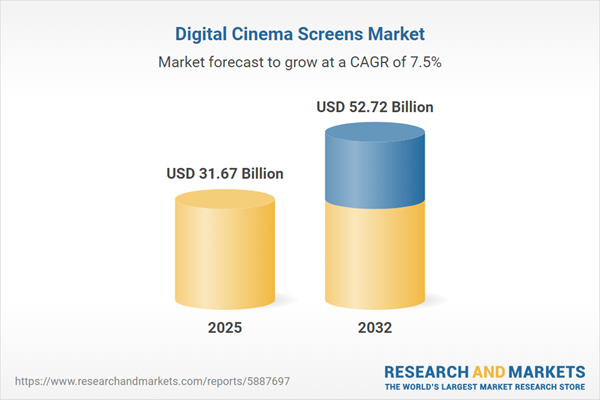Speak directly to the analyst to clarify any post sales queries you may have.
The digital cinema screens market is experiencing dynamic transformation, fueled by ongoing innovation in display technologies and evolving audience preferences. As global entertainment shifts towards immersive and interactive experiences, industry stakeholders must strategically navigate new opportunities and emerging challenges to remain competitive.
Market Snapshot: Digital Cinema Screens Market Size and Growth
The Digital Cinema Screens Market grew from USD 29.60 billion in 2024 to USD 31.67 billion in 2025. Sustaining robust momentum, the sector is projected to reach USD 52.72 billion by 2032 at a CAGR of 7.48%.
Scope & Segmentation
- Screen Types: Indoor, Outdoor
- Technologies: 2D, 3D (Active Shutter, Passive Polarized), 4D (Motion Seats, Special Effects), LED
- Hall Types: Drive In, Multiplex, Single Screen
- Resolution: 2K, 4K, 8K
- Applications: Advertising, Entertainment
- End Users: Advertising Agencies, Cinema Operators, Event Organizers
- Regional Coverage: Americas (United States, Canada, Mexico, Brazil, Argentina, Chile, Colombia, Peru), Europe, Middle East & Africa (United Kingdom, Germany, France, Russia, Italy, Spain, Netherlands, Sweden, Poland, Switzerland, United Arab Emirates, Saudi Arabia, Qatar, Turkey, Israel, South Africa, Nigeria, Egypt, Kenya), Asia-Pacific (China, India, Japan, Australia, South Korea, Indonesia, Thailand, Malaysia, Singapore, Taiwan)
- Companies: AMC Entertainment Holdings, Inc.; AOTO Electronics Co., Ltd; Barco NV; Christie Digital Systems USA, Inc.; Cinemeccanica S.p.A.; D2 Systems d.o.o.; Digital Projection Ltd. by Delta Group Company; Galalite Screens; GDC Technology; Harkness Screens International Ltd; IMAX Corporation; Moving Image Technologies Inc.; NEC Corporation; Qube Cinema Technologies Private Limited; Radiant Vision Systems, LLC; RealD Inc.; Samsung Electronics Co., Ltd.; Severtson Corp.; Sharp NEC Display Solutions, Ltd.; Shenzhen Timewaying Ltd; Sony Corporation; SPECTRO CO., LTD.; Texas Instruments Incorporated.
Key Takeaways for Senior Decision-Makers
- Technological advancements such as LED, 4D, and advanced 3D screens are significantly enhancing the cinematic experience, prompting exhibitors to update infrastructure and rethink content delivery.
- Customized solutions are gaining momentum, reflecting diverse audience preferences and unique venue configurations across global markets.
- Collaborative programming with event organizers and advertisers is accelerating, supported by hybrid screens capable of showcasing live events and branded content alongside films.
- Personalized content and analytics-driven audience engagement are enabling cinema operators to optimize programming and boost attendance rates.
- Regional market drivers vary widely, with urbanization and disposable income fueling expansion in Asia-Pacific, while Western markets emphasize sustainability and energy efficiency.
- Active partnerships between technology providers, cinema chains, and content creators are central to sustaining innovation and addressing rising consumer expectations.
Tariff Impact: Navigating Trade Policy Shifts
Recent changes to United States tariffs on imported components have prompted manufacturers to reassess sourcing and supply chain strategies. Diversifying suppliers, investing in localized production, and prioritizing vertical integration are resulting in better cost management and increased resilience. Stakeholder alliances are evolving as businesses and policymakers work together to address trade stability, safeguard advanced technologies, and maintain operational continuity.
Methodology & Data Sources
This report adopts a comprehensive methodology, combining primary interviews with industry stakeholders and secondary research from trusted industry publications and regulatory sources. Data and insights are rigorously validated through peer expert panels and cross-checked for consistency and accuracy, ensuring reliability across diverse global markets.
Why This Report Matters
- Enables senior executives to identify high-impact growth opportunities and adapt strategies for evolving technology trends in the digital cinema screens market.
- Provides actionable insights on consumer expectations, shifting regulatory environments, and competitive landscape, supporting evidence-based investment decisions.
- Supports supply chain and procurement leaders in optimizing sourcing and risk management as trade dynamics evolve.
Conclusion
As the digital cinema screens market transforms, competitive advantage hinges on technological agility, strategic partnerships, and proactive adaptation. This report equips industry leaders to drive sustainable growth and shape the future of cinematic engagement worldwide.
Additional Product Information:
- Purchase of this report includes 1 year online access with quarterly updates.
- This report can be updated on request. Please contact our Customer Experience team using the Ask a Question widget on our website.
Table of Contents
3. Executive Summary
4. Market Overview
7. Cumulative Impact of Artificial Intelligence 2025
Companies Mentioned
The companies profiled in this Digital Cinema Screens market report include:- AMC Entertainment Holdings, Inc.
- AOTO Electronics Co., Ltd
- Barco NV
- Christie Digital Systems USA, Inc.
- Cinemeccanica S.p.A.
- D2 Systems d.o.o.
- Digital Projection Ltd. by Delta Group Company
- Galalite Screens
- GDC Technology
- Harkness Screens International Ltd
- IMAX Corporation
- Moving Image Technologies Inc.
- NEC Corporation
- Qube Cinema Technologies Private Limited
- Radiant Vision Systems, LLC
- RealD Inc.
- Samsung Electronics Co., Ltd.
- Severtson Corp.
- Sharp NEC Display Solutions, Ltd.
- Shenzhen Timewaying Ltd
- Sony Corporation
- SPECTRO CO., LTD.
- Texas Instruments Incorporated
Table Information
| Report Attribute | Details |
|---|---|
| No. of Pages | 183 |
| Published | November 2025 |
| Forecast Period | 2025 - 2032 |
| Estimated Market Value ( USD | $ 31.67 Billion |
| Forecasted Market Value ( USD | $ 52.72 Billion |
| Compound Annual Growth Rate | 7.4% |
| Regions Covered | Global |
| No. of Companies Mentioned | 24 |









